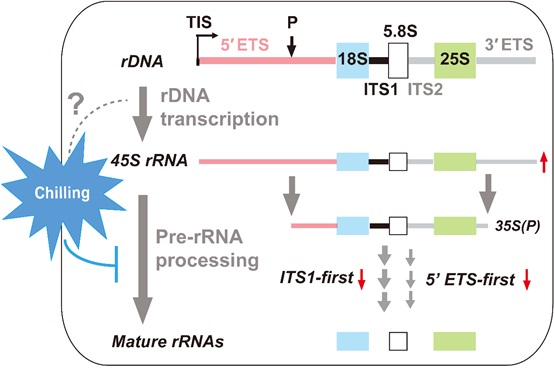Ribosome biogenesis is highly complicated and energy consuming, as one of the most fundamental cellular progress. It begins with transcription of the rDNA by RNA polymerase I (Pol I). The resulting pre-rRNA transcript undergoes systematic processing, where multiple endonucleolytic and exonucleolytic cleavages remove the external and internal transcribed spacers (ETS and ITS). rRNA biogenesis has been deciphered in Saccharomyces cerevisiae and, to some extent, in Xenopus, mammalian cells, and Arabidopsis thaliana. However, the processing sites and pathways remain largely unknown in crops, particularly in monocots such as rice, one of the most important food resources in the world.
A team led by Dr. CAO Xiaofeng at Institute of Genetics and Development Biology, Chinese Academy of Sciences, revealed rRNA biogenesis and its response to chilling stress in rice.
They identified the rRNA precursors produced during rRNA biogenesis and the critical endonucleolytic cleavage sites in the transcribed spacer regions of pre-rRNA in rice. They further found that two pre-rRNA processing pathways, distinguished by the order of 5′ ETS removal and ITS1 cleavage, co-exist in vivo.
Rice originated from tropical and subtropical regions. Therefore, rice cultivated in temperate zones can exhibit more sensitivity to chilling stress than other crops such as barley (Hordeum vulgare L.) and wheat (Triticum aestivum L.). Accordingly, rice has evolved to adapt to chilling stress. Dr. CAO’s team identified that exposing rice to chilling stress resulted in the inhibition of rRNA biogenesis mainly at the pre-rRNA processing level, suggesting that these energy-intensive processes may be reduced to increase acclimation and survival at lower temperatures.
Overall, their study identified the pre-rRNA processing pathway in rice and showed that ribosome biogenesis is quickly inhibited by low temperatures, which may shed light on the link between ribosome biogenesis and environmental acclimation in crop plants.
The findings are published online in Plant Physiology entitled “Ribosomal RNA Biogenesis and its Response to Chilling Stress in Oryza sativa L.” on March 19, 2018. Dr. HANG Runlai is the first author of the paper.
This work was supported by National Natural Science Foundation of China, the National Key Research and Development Program of China, and the China Postdoctoral Science Foundation.
Figure: Working model of rRNA biogenesis and its response to chilling stress in rice (Image by IGDB)
Contact:
CAO Xiaofeng
Institute of Genetics and Development Biology, Chinese Academy of Sciences
 Figure: Working model of rRNA biogenesis and its response to chilling stress in rice (Image by IGDB)Contact:CAO XiaofengInstitute of Genetics and Development Biology, Chinese Academy of SciencesEmail: xfcao@genetics.ac.cn
Figure: Working model of rRNA biogenesis and its response to chilling stress in rice (Image by IGDB)Contact:CAO XiaofengInstitute of Genetics and Development Biology, Chinese Academy of SciencesEmail: xfcao@genetics.ac.cn CAS
CAS
 中文
中文




.png)
